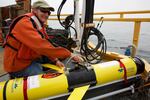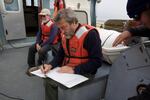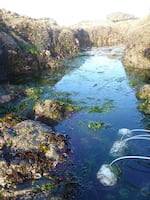
OSU oceanographer Jack Barth prepares a glider that will spend weeks flying through the ocean, collecting data on ocean acidification and oxygen levels.
Kristian Foden-Vencil / OPB
Scientists say warming ocean temperatures mean Oregon's coastal waters now have a low-oxygen season, or hypoxia season, just as the state's forests have a fire season.
Hypoxia is a condition in which the ocean water close to the sea floor has such low levels of dissolved oxygen that the organisms living down there die.
Some of the first signs came in 2002 when dead crabs were hauled up in crab pots. Since then, scientists and crabbers say things have worsened.
"We can now say that Oregon has a hypoxia season much like the wildfire season," said Francis Chan, co-chair of the West Coast Ocean Acidification and Hypoxia Science Panel.
"Every summer we live on the knife's edge and during many years we cross the threshold into danger – including the past two years. When oxygen levels get low enough, many marine organisms who are place-bound, or cannot move away rapidly enough, die of oxygen starvation," he said.
"Hypoxia is something we rarely saw throughout the 20th century, but have seen almost annually since the year 2002."
The low-oxygen conditions are caused by warmer ocean temperatures. Those trigger excessive phytoplankton blooms, and when those organisms die they sink to the ocean bottom and suck the oxygen out of the water.
Exacerbating the problem is the lack of mixing ocean waters, as changing wind patterns have led to stratification of ocean layers.

NOAA fisheries biologist, Curtis Roegner records scientific data on the health of crab populations. Low-oxygen levels have killed off large populations of crabs during hypoxia events in the past.
Kristian Foden-Vencil / OPB
Oregon State University oceanographer and co-chair of the Oregon Coordinating Council on Ocean Acidification and Hypoxia, Jack Barth, is collecting data to draw the first hypoxia maps of Oregon's coast.
Related: 'There Aren't A Lot Of Other Options:’ Port Orford’s Season Of Crab And Crisis
“We’re actually seeing real interest from the fishing community. They know how to look at our data and say, ‘Where are the layers in the ocean? Where is the high and low oxygen?'" Barth said.
Barth said some Oregonians who make their living from the sea have been aware of the problem for a long time and brought it to the attention of researchers.
"Scientists keep saying that the ocean is changing along with the climate, and people are beginning to get in tune," said Barth. "They see the heat waves and all the smoke from wildfires and are beginning to realize that this is something different."
“The crabbing and the oyster industries were ahead of the curve. They were among the first to notice that the ocean just off our coast is changing and was affecting their livelihoods. And they have been working with scientists ever since.”
Those same industries alerted people to a different problem — ocean acidification — in 2007. The Whiskey Creek Shellfish Hatchery on Netarts Bay experienced massive die-offs of larval oysters. That threatened to destroy the hatchery’s entire operation.
OSU researchers Burke Hales and George Waldbusser responded and found the problem was highly acidified water and that the hatchery could mitigate it by drawing water from the bay at certain times of the day, or treating the water to lower its corrosiveness.
Related: West Coast Ocean Acidification Rates Among Highest In World
Further research found acidification didn’t destroy oyster shells but prevented them from developing in the first place.
“Scientists from Oregon State have been involved since day one on both the emerging challenges of coastal ocean hypoxia and ocean acidification,” said Caren Braby, marine resources program manager at the Oregon Department of Fish and Wildlife and co-chair of the Oregon Ocean Acidification and Hypoxia Council.
Scientists say rising levels of carbon dioxide, attributed to the burning of fossil fuels, are major drivers of increased ocean acidification.
In its first biannual report to the Legislature, Oregon's Hypoxia Council said the state needs more monitoring and policy direction on this problem.

Ocean acidification sensors in rock pools.
Courtesy of Oregon State University
